 |
| WPP Marketing's CEO Andre Nair: Size
does matter |
AGENCY
Let's WPP The Competition
One-year old WPP Marketing Communications is
India's biggest media agency.
Quick, name India's
biggest advertising agency? JWT India (formerly HTA)? No. O&M?
Wrong again. Mudra? Never mind, you aren't going to get this one;
the position belongs to the year-old WPP Marketing Communications
India, part of the eponymous $16.5-billion (Rs 79,200 crore) advertising
conglo created by Martin Sorell. With over 30 clients across its
three operating divisions, MindShare, which buys media for JWT India,
Maximize, which represents all other conflicting businesses with
either Ogilvy & Mather and Contract Advertising, and Fulcrum,
which buys media exclusively for Hindustan Lever Limited (for the
record, the fast moving consumer goods behemoth consumed an estimated
Rs 700 crore of advertising space in 2002), WPP Marketing Communications
already boasts billings around Rs 1,500 crore.
It isn't size alone that qualifies WPPMC for
this honour; the company's entry into the staid calculator and spreadsheet
heavy world of media planning has revolutionised the discipline.
Self respecting media pros are no longer keen to be part of traditional
full-service agencies. They'd rather work for WPPMC, Starcom India
(part of the bcom3 network), or Havas Communications' Media Planning
Group.
With a focus on media consulting through its
Advanced Techniques Group (ATG), non-traditional media through BroadMind,
and consumer behaviour, through Media Consumer Insight (MCI), WPPMC
doesn't just offer customers an avenue to improve their advertising
efficiency, it provides media pros with an environment in which
they can excel.
Expectedly, with one agency now in charge of
buying media for three of India's largest agencies-JWT India, O&M,
and Contract Advertising-2002 has seen a redefinition of the term
'buying clout'. But what else would you expect from our choice as
agency of the year.
-Shailesh Dobhal
 |
| Gujarat CM Narendra Modi: Brand for the
future |
BRAND
Make Way, Orange
Militant Hindu nationalism now has a brand personification:
a triumphant Chief Minister.
Till just the other
day in-your-face hindutva (the Hindu way) was a faceless ideology.
In 2002, it found in Gujarat Chief Minister Narendra Modi, the perfect
personification of its core values. Now, Modi seems to have emerged
the Bharatiya Janata Party's strongest and newest political product,
pre-packaged and ready to be marketed across India, starting 2003,
when nine states go to the polls. In hindsight Deputy Prime Minister
L.K. Advani's legendary Rath Yatra (chariot journey) of 1990 seems
merely a successful below-the-line promotion.
So, if, after Gujarat, the BJP is a born-again
political force, Modi must surely be its unique selling proposition.
The man isn't just being credited for the party's victory in the
state, he has emerged the visible (and saleable) face of Hindutva
and the party, and wagers are being made about when he will make
a shift to national politics, and as what. If Modi manages to successfully
make the shift from a dominant regional brand to national market
leader-and 2003's elections will be the test of that-Indian politics
will never be the same again.
-Shailesh Dobhal
 |
| M&M's Scorpio: There's a sting in
this tale |
CAR
The Ute's A Brute
M&M proves that it is possible to build
a good-looking Indian SUV.
The year may have
seen the launch of the new Mercedes e Class in India-it boasts,
ride-by-wire technology-but it is M&M's sports-UTE Scorpio that's
our choice of car of the year. The company sells all the 1,300 Scorpios
it produces each month and is now upping output to 2,000. That,
despite increasing reservations about the Scorpio's ride-quality,
handling, and engine-noise, should suffice.
-Suveen K. Sinha
DEAL
Softly Does It
Patni Computer places $100 m of its equity with
General Atlantic.
In a year dominated
by big-ticket public sector acquisitions (VSNL, IPCL, IBP et al),
one significant private equity deal got buried under the disinvestment
snowball: the $100 million pumped by it fund General Atlantic Partners,
via the equity route, into the unlisted software major, Patni Computer
Systems. The deal is noteworthy because Patni wisely decided to
skip the IPO route to raise money, thanks to sluggish stockmarket
conditions, and instead opted for a private equity deal to raise
money.
-Brian Carvalho
 |
| Ten Sports: Anything but a perfect 10 |
FLOP
Ten, There Was None
Even the football world cup couldn't
save this channel.
The football world
cup has come and gone, and Taj Television Limited's Ten Sports'
chances seem to have waned with its passing.
True, the channel effected a coup of sorts
bagging Indian broadcast rights for the event over ESPN-Star and
others in the fray, but in the 12 months of 2002, in cricket-crazy
India, Ten Sports could not manage even a single live broadcast
of cricket involving India. That's because the channel's cricket
rights are restricted to games played in Sri Lanka, which Indians
didn't tour, Sharjah, that India won't tour, and Morocco, which
is still an emerging cricketing destination.
Things are unlikely to get better. SET max
boasts the Indian broadcast rights for next year's cricket world
cup in South Africa. Viewers will have to wait until 2003-that's
when India tour Sri Lanka-to watch their favourite team on Ten Sports,
but will that be too little, too late in a World Cup year?
-Shailesh Dobhal
EPITHET
The Supreme Court's Snub
Trust the SC to know how to tick-off
someone without using a single epithet.
Never has a tribunal
been ticked off by anyone like the telecom Dispute Settlement Appellate
Tribunal (TDSAT) was by the Supreme Court in its December 17 judgment
on wireless in local loop (WiLL). According to the court, the tribunal's
order giving the green signal to will on the CDMA platform did not
fulfil the criteria of a judgment. It had failed to address whether:
WiLL with limited mobility was a new service;
It violated the TRAI Act;
The contractual rights of cellular operators
had been infringed upon;
CDMA mobile could substitute GSM mobile; or
CDMA represented a march of technology;
That's not all. The judgement says TDSAT arrived
at some findings without referring to any material on record, had
not considered the materials placed before it on the issue of a
level playing field, and that it should invoke consumer interest
only after determining the legality of the service. Someone out
there in the tribunal must be wishing the court had restricted itself
to epithets
-Suveen K. Sinha
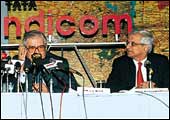 |
| The Tata WiLL launch: Little risk |
GAMBLE
Uncharted Territory
Tatas and the Ambanis decide to push
ahead on limited mobility.
The Tatas have
never been known to be betting men, but by being the first to launch
limited mobility telephony, even as the Supreme Court's decision
on the fate of this service continues to hang fire, they've indeed
taken a gamble. Ditto for the Ambanis, who launched last fortnight.
Call it a calculated gamble. For there's always Plan B.
-Brian Carvalho
 |
| Carrier Aircon's Moos: A tough find |
HEADHUNT
In From The Cold
India's once premier air-conditioning
company finally found a CEO.
It must rank as
one of the toughest searches ever in India Inc. For nine months
after Anil Srivastava quit as CEO of Carrier Aircon (in July 2001),
the company didn't have a chief executive. The parent called in
the services of old Indian hand G. Raghavan and hired an international
search firm to find a replacement. Finally, in July 2002, after
the search changed hands, Mumbai-based Shilputsi Consultants, identified
former Goodyear India CEO Neville P. Moos, then working in the US
as an independent consultant. Moos is currently trying to win back
some share from Korean twins LG and Samsung.
-Seema Shukla
 |
| Bharti Televentures' Sunil Mittal: Will
he prevail? |
IPO
Telecom's First
It had to be the first major issue by
a telco.
In the end, 2002
turned out to be a horrible year for Initial Public Offerings. In
all, six issues managed to raise Rs 1,981 crore from investors.
Of that, Bharti Televentures' mopped up Rs 834 crore from a 100
per cent book-building issue-the first of its kind in India-that
was over-subscribed 2.5 times. In one swoop, the IPO of 10 per cent
of the company's stock gave it a valuation of Rs 7,803.67 crore.
That was the only good news for Bharti's Chairman and Managing Director
Sunil Mittal. The shares were picked up at Rs 45, listed at Rs 55
but soon touched a low of Rs 22. On December 26, the stock was trading
at Rs 23.45. Clearly, while telecom is a long-term play, the market
is unwilling to look beyond traditional metrics such as earnings
and net profit. Alas!
-Roshni Jayakar
JACKPOT
Twist In The Tail
Surprise, surprise, it was VSNL.
In February 2002,
when the Tata Group paid Rs 1,439 crore for the government's 25
per cent stake in Videsh Sanchar Nigam Limited most people thought
Disinvestment Minister Arun Shourie has struck the jackpot. That
view gained ground as the government scotched a decision by VSNL's
new masters to burn Rs 1,200 crore of its reserves on a 22-26 per
cent stake in Tata Teleservices.
In hindsight, though, the windfall seems to
have been the group's. The government has agreed to have the company
invest Rs 835.8 crore for a 19.9 per cent stake in Tata Teleservices.
Seen in the context of VSNL's revenues (over Rs 7,000 crore), the
Tata Group seems to have got a bargain.
-Suveen K. Sinha
 |
| Minister of State for Surface Transport B.C.
Khanduri : Goldfinger? |
KEYNESIANISM
On The Road Again
There's just one government initiative
that qualifies.
Keynes would have
approved of the Golden Quadrilateral, the government's efforts to
connect the four metros of the country by building some 5,846 kilometre
of highway at the cost of Rs 30,300 crore. In 2002-03, for instance,
the National Highway Development Project, as it is christened-it
has the blessings of Prime Minister Atal Behari Vajpayee himself-will
see the creation of nearly 4,500 kilometre of roads at an estimated
cost of Rs 18,000-20,000 crore. For a country starved of other big
projects-the government has little to spare and India Inc., reeling
under the impact of a near slowdown, has chosen to focus on efficiencies
rather than growth-that is nothing short of manna. Forget the long-term
impact of what this will do for India's transportation infrastructure
and look at the immediate gains: an annual consumption of 30-40
lakh metric tonnes of cement and 300,000 metric tonnes of steel
and daily employment for over 250,000. Truly Keynesian.
-Ashish Gupta
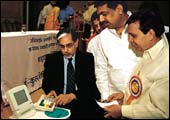 |
| Playwin's Subhash Chandra: Change success |
LAUNCH
Punch Your Own Luck
A $155 billion market globally, it finally
made an entry into India.
Every week 22 million
people-the numbers continue to grow-participate in an online game
of chance organised by Playwin Infrawest, a Subhash Chandra-promoted
company, across 14 Indian states; the results are aired live on
Zee Television, and the success of the model has encouraged Modi
Entertainment Network's subsidiary MWC Market Services, and Martin
Lotteries to enter the business. Welcome to the world of online
lotteries, where customers pick their own winning numbers, and punch
out their tickets from slot machines; Playwin has 4,300 such across
the country. With a potential market of Rs 100,000 crore a year-the
Rs 47,000-crore textiles and garments market and the Rs 42,000-crore
fast moving consumer goods market pale in significance-Playwin,
and the other companies can look forward to a lucrative future.
"Ours is like the FMCG business, where we are building each
lottery draw as a brand," says Sanjay Das, CEO Playwin. By
March 2003, the company will expand its network to 10,000 machines.
Put all the numbers together, and you'll realise why this has to
be the launch of the year.
-Shailesh Dobhal
 |
| RIL's Anil Ambani: Come together |
MERGER
Here Comes The Giant
RIL-RPL merger saw the coming of a Rs
60,000-crore monolith.
In a year when
there wasn't much merger action, there shouldn't be any prizes for
guessing who gets the consolidation crown. Yes, it has to be the
Ambanis for their merger of flagship petrochemicals manufacturer,
Reliance Industries, into the refining major, Reliance Petroleum.
The deal may not score too many points on the innovation and predictability
parameters, but it's the sheer size of the merged entity that gives
it pride of place.
By creating a close to Rs 60,000-crore giant,
the Ambanis have strolled into the Fortune 500 list. That's more
of a fringe benefit than being one of the drivers for the merger.
The major advantage is that the Ambanis now
have a stronger balance sheet that, in turn, is expected to be beneficial
in raising money to take on global petroleum giants as well as in
bidding for public sector undertakings. IPCL's in the bag. Any guesses
as to what's next?
-Brian Carvalho
 |
| BPO execs: Calling card to success |
OCCUPATION
Back-Office Boom
Hint: 160,000 more joined the ranks in
2002.
It was the sector
that saw the most hiring action-GE capital International Services
alone did 18,000 in the course of the year-and, according to hr
consulting firm Hewitt Associates, the highest average salary increase,
16.4 per cent. Business Process Outsourcing didn't just create jobs
at the agent level, it made, and re-made CEO careers. Neeraj Bhargava,
the former head of venture capital outfit eVentures, moved as head
of the British Airways BPO company WMS and Electrolux's Ram S. Ramsundar,
as CEO of Satyam's BPO initiative Nipuna. With a growth rate in
excess of 60 per cent and average attrition rate of anything between
35 per cent and 60 per cent, the action in BPO will continue well
into 2003.
-Seema Shukla
 |
| The Dabhol Plant: As NP as NPAs come |
NPA
The Big E
Rasiklal Mardia's may have made the headlines,
but it was a different NPA to which the honour goes.
Fine, let's split
some hairs: officially, it is still a standard asset; unofficially,
it is clearly the non-performing asset of the year. The exposure
of financial institutions and banks, together, to the Rs 13,000-crore
Dabhol Power Company (DPC) stands at Rs 6,200 crore. In the past
18 months, the company has generated neither income nor electricity.
And so, the fate of IDBI's Rs 2,121 crore, SBI's Rs 1,749 crore,
ICICI's Rs 1,473 crore, IFCI's Rs 454 crore, Canara Bank's Rs 407
crore, and the rest hangs in balance. The subsidiary of the infamous
Enron Corp. missed its first loan repayment in April 2002. Other
defaults followed: one in June, and another in September. The IDBI-led
consortium (listed above) has applied to the RBI for permission
not to treat their loans as NPAs. There it stands.
-Roshni Jayakar
POLICY-MAKER
Sush's The Word
One minister was responsible for two
media-related legislations.
Some of India's
media tycoons hate competition in any form. So, when the government
initiated moves to allow 26 per cent foreign direct investment in
print media, the very people who call for more economic reforms
and an open market through the columns of their publications, did
a volte face and insisted no foreign investment be allowed in the
sector. Fortunately for the free market, I&B Minister Sushma
Swaraj prevailed. Later in the year, she even managed to get Parliament
to approve Conditional Access System, thereby revolutionising the
way the broadcast and cable industries work. Bravo!
-Ashish Gupta
REVIVAL
Steel's Stainless
The Indian steel industry engineers a
miraculous turnaround.
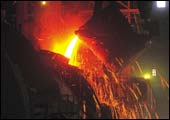 |
| Indian steel: The good times are back |
For years, happenings
in the Indian steel industry were the stuff of which tear-jerkers
are made- over-capacity, falling prices, and poor demand. Last year,
finally, things started looking up.
A Fitch Ratings report on the Indian steel
sector estimates prices to have increased between 6 per cent and
14 per cent. During April-September 2002, finished steel production
went up by 7.4 per cent against a 0.36 decline in 2001.
On the domestic front, demand picked up in
the course of the year in anticipation of further price hikes. The
government's Golden Quadrilateral project (see story in this section
for how much steel it consumes) and Urban Reform Scheme are expected
to cause a further increase in demand in 2003.
With the OECD countries agreeing to shut 125
million tonnes of inefficient steel making capacity over the next
three-to-five years, demand for Indian steel could go up in export
markets too. China, for instance, will need to import a significant
amount of steel to keep up the pace of its urban renewal. It is
on the basis of factors such as these that Fitch predicts a 11 per
cent growth rate for the sector, as compared to a 5.6 per cent increase
in global demand. Surely, that must count as the year's biggest
revival.
-Roshni Jayakar
QUEST
Is There Anybody Out There?
After 23 months in court, things are
none the clearer.
India's cellular
operators first challenged the government's decision to allow basic
telephony companies offer mobile services on January 22, 2001. They
may have found some succour in end-2002, courtesy a Supreme Court
judgement that directed the Telecom Dispute Settlement Appellate
Tribunal to re-examine the issue and create a level playing field
in telecom. Still, with the court coming down heavily on the tribunal
for its previous laxity, the latter is likely to take its time doing
a thorough job (no one likes another rebuke). The quest, therefore,
continues...
-Suveen K. Sinha
STOCK
JISCO, Anyone?
A low-profile steel company surprises
everyone.
The year may have
belonged to PSU scrips that gained ground following the government's
disinvestment process, but in numerical terms it was the Jindal
Iron & Steel Company (JISCO) stock that outperformed all comers.
The scrip rose 970 per cent between January and December, moving
from Rs 4 to a high of Rs 73 (it now trades at around Rs 55); the
Sensex rose 3.6 per cent in the same period.
The market's sudden faith in the future of
the maker of flat steel products can be attributed to the overall
revival in the steel market. JISCO exports 54 per cent of its production
and the increase in global demand, especially from CIS countries
investing in infrastructure, augurs well for it. With sales of Rs
1,051 crore in 2001-02, JISCO, part of the Rs 7,000-crore Jindal
Group, is still an attractive stock. A stock price of Rs 73 may
not seem to be much in the context of India's software superstar
but, believe you us, in steel, it is as good as gold.
-Roshni Jayakar
TORCH-BEARER
It's The PM!
A beleagured patriarch is still the reforms
process' biggest champion.
 |
| Prime Minister Atal Bihari Vajpayee: Reforms'
# 1 proponent |
Guess where much
of India's economic policy gets made these days? And guess, who
is drawing up the blueprint for the next generation of reforms?
We'll spare you the blushes and get straight to the answer. The
Prime Minister's residence, #7 Race Course Road and his office in
South Block are where the policy is made. And the draft for nex-gen
reforms is being drawn up by the Prime Minister's Office. Neither
answer comes as a surprise: with much economic policy-making these
days revolving around contentious issues such as disinvestment,
labour reforms, foreign direct investment and the like, the Prime
Minister finds it necessary to step in and function as a jamcracker.
There can be no doubts over the man's own commitment to reforms:
he has, time and again, spoken about how he'd like to see the Indian
economy grow at 8 per cent a year. And he has, time and again, risen
to the support of his beleagured pro-reform colleagues-Disinvestment
Minister Arun Shourie is one beneficiary. Still, with electoral
considerations likely to dominate the thinking of most political
parties over the next two years, the question is not what Vajpayee
can do, but how much he can do without hurting his party's chances.
-Ashish Gupta
UTILITY
The Water-Method Firm
It's French and it traffics in water.
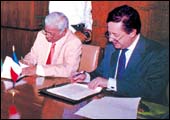 |
| The French connection: Tata Steel and
Vivendi ink the deal |
What's a French
company doing supplying water in the heart of Jharkhand? The company
in question is Vivendi, the global leader in water and wastewater
management services, and in November 2002, it signed a memorandum
of understanding with Tata Steel to create a joint venture that
would manage the water supply in steel town Jamshedpur.
If all goes well, starting mid-January, the
joint venture-the assets will remain with Tata Steel, while Vivendi
will run the utility-will supply 35.5 million gallons of water to
1 million people and pipe and recycle some 60,000 cubic metres of
wastewater everyday. For Tata Steel, this is just another in a long
list of efforts to focus on its core business. And for Vivendi-it
already works with the Kolkata Municipal Corporation and the Chennai
Water Board to make their water supply networks more efficient-it
is the logical next step.
-Ashish Gupta
VACANCY
The Seat's Hot Again
It got filled, but that was a surprise.
 |
| Idea Cellular's Burke (left): The right
thought |
If everyone had
stuck to the script, the merger of the AT&T-Birla-Tata combine's
cellular operation, and BPL Communications would have gone through
without a hitch. And BPL CEO Rajeev Chandrasekhar would have become
CEO of the merged entity.
The buzz had it that AT&T-Birla-Tata CEO
Sanjeev Aga put in his papers in October 2001, because he knew this
was in the offing.
The combine started its search for a new CEO,
and every headhunter in town wanted to be part of the action, but,
in part because of uncertainty over the merger, and, in part because
good telecom CEOs seemed suddenly in short supply, the post remained
vacant, presumably for Chandrasekhar.
By mid-2002, though, it was evident the merger
wouldn't go through (although the official line is that it is still
on). Idea Cellular-as the combine is now known-may have finally
decided that it was time to get on with life without waiting for
the merger to happen. After all, it had bid for the fourth cellular
licences independently.
So, just prior to the launch of its services
in Delhi, the company unveiled a new CEO, expat Graham Burke, who
has made a career out of successfully running telcos in Asia. His
last stint was as President of Pakistan's Mobilink Communications.
Idea's Delhi ops are off to a start, but with competition from the
likes of Bharti, Hutch, and now Reliance India Mobile, the going
will be anything but easy for Burke.
-Seema Shukla
 |
| TRAI's M.S. Verma: Hello? |
WAIT OF THE YEAR
Verma's Inertia
Waiting for Verma has become the pastime-by-default
of India's telecom execs.
The world over,
telcos take interconnect, the right to connect to other networks,
for granted. Not so in India, where interconnect is often a way
to keep the competition at bay. Here's a sampling of the year's
interconnect woes: Bharti Televentures' IndiaOne domestic long distance
service began the year by trying to connect with the fixed service
networks of BSNL and MTNL that, together, account for 95 per cent
of India's basic telephony customers. While it has managed to hammer
out an agreement, interconnectivity proves elusive. Then the newly
privatised Videsh Sanchar Nigam Limited found itself facing the
combined bargaining power of its former stablemates BSNL and MTNL.
And now companies providing limited mobile services on the CDMA
platform are at loggerheads with cellular companies over interconnectivity.
Much of the problem stems from the Telecom Regulatory Authority
of India's position that service providers need to work out interconnect
agreements themselves. They cannot deny connectivity, it warns,
but they can approach it only when all else fails. Wouldn't it have
just been simpler to set some guidelines for interconnect?
-Suveen K. Sinha
XENOPHOBE
By George, It's George
The enfant terrible of the out-damned-foreign-company movement returns.
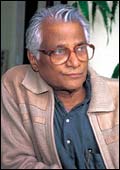 |
| Defence Minister George Fernandes: Coke,
anyone? |
All those who thought
the man widely considered responsible for the exit of Coca-Cola
and IBM from the country in 1977 had become more market-friendly
were in for a rude shock in 2002. Defence Minister George Fernandes
has joined the Left parties, the RSS, and the SJM as yet another
opponent of the reforms process. This time, though, his ire wasn't
targeted at a foreign company, or two, but at a foreign idea, disinvestment.
In a letter to Prime Minister Atal Bihari Vajpayee,
he alleged that monopolies were being perpetuated by allowing private
sector giants to bid for and acquire public sector companies. Retail
investors, and other public sector firms, he continued, needed to
be included in the process. ''Disinvestment should not be such that
it makes the rich richer,'' he later said in Parliament. Some attribute
Fernandes' sudden opposition to disinvestment, as something that
is being encouraged by a certain corporate group. Others put it
down as an effort to cosy up to RSS Chief K.S. Sudershan as an effort
to stay relevant at the end of the government's term. Whatever it
be, he's back.
-Ashish Gupta
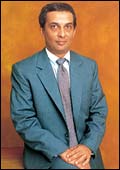 |
| Franklin Templeton's Ravi Mehrotra: Ace |
YOUNG ACHIEVER
Our Mutual Friend
A mutual fund manager proves that it's
easy to win when you know how.
Mutual funds didn't
do too well last year. But Franklin Templeton did. Some credit for
that should go to its President Ravi Mehrotra, a 41-year-old who
moved to the company when it acquired Pioneer ITI-he had been Chief
Investment Officer of the latter. In July 2002, when the merger
took place, the combined asset size of the two entities was Rs 7,800
crore. By December 2002, the figure was Rs 9,400 crore. A growth
of 20.5 per cent in five months may not look impressive, but as
Mehrotra points out: ''The mutual fund industry has grown its asset
size 20 per cent in the past five years.'' Mehrotra's task was no
doubt made easier by the nature of the merging entities: ITI Pioneer
was a retail big-wig, while Templeton was focused largely on fixed
instruments. Now, with a band of talented fund managers in place,
Mehrotra is scripting 2003 as the "year of delivery".
-Moinak Mitra
ZEITGEIST
Back With A Vengeance
The year 2002 saw
the startling resurgence of an aggressive brand of nationalism.
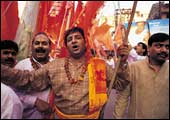 |
| Strangely doctored love: Where does it
lead? |
If at first you
don't succeed, try, try, try a djinn. As in 'spirit', of course,
except that we're not talking about Johnnie Walker Black Label,
which spent the year exhorting us to keep walking. Nor about ac
Black, which was trying to redefine the limits of intoxicated possibility.
No, these brands don't qualify.
For India, it was the year of now-on-now-off
privatisation, and of the now-on-now-off nationalism-socialism relationship
at the Centre...which was expected to rupture. Did it? No such luck.
Of late, though, nationalism certainly seems to have gained ideological
dominance. And a particular brand of it, conceived back in the 1920s
(and uncorked many decades later), has certainly achieved top-of-the-mind
prominence at the zeitgeist hustings for 2002. So, should this eight-lettered
occupant of mass mindspace be awarded the year's spirit-of-the-year
title? Oh well...as people'll have it. Such is the attraction to
all things vapourised.
-Aresh Shirali
|

